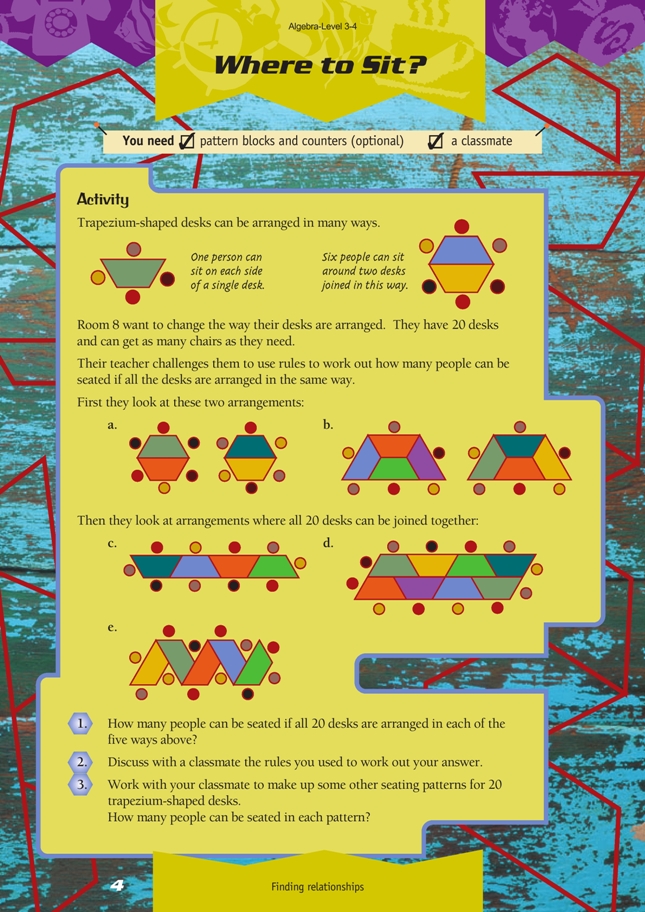This is a level 4 algebra strand activity from the Figure It Out series.
A PDF of the student activity is included.
Click on the image to enlarge it. Click again to close. Download PDF (525 KB)
use tables to find the relationship in geometric patterns
FIO, Level 3-4, Algebra, Where to Sit? page 4
classmate
This activity is similar to those on pages 1 and 3. The students need to find and use rules to describe the relationships in geometric patterns. Using 20 desks is a deliberate strategy to make adding on (recursive) rules cumbersome. This should encourage the students to develop more efficient function rules.
Using tables will help the students to see connections between the number of desks and the number of chairs. A table for question 1c could look like this:
Two more chairs can be used for each new desk that is added to the line. Repeated addition of 2 is the same as multiplication by 2, so the students could try this as a possible function rule that links the number of desks with the number of chairs.
The students will quickly see that they need to add 2 more to each “times 2” result to get the number of chairs. So a “times 2 plus 2” function rule will work. This could be written algebraically as c = 2d + 2, where c is the number of chairs and d is the number of desks. As an extension, you could give the students this desk arrangement:
The relationship between desks and chairs in this arrangement is more complex.
.gif)
This pattern is not linear because the increases in the number of chairs for each desk added are not constant. To describe the rules algebraically, the students would need to split the number of desks into three classes of numbers, {1, 4, 7, …}, {2, 5, 8, …}, {3, 6, 9, …}, and produce different rules for each class. This is beyond the ability of students at levels 3 and 4. For example, the rule for the numbers of desks that are multiples of three, {3, 6, 9, …}, is c = 4/3d + 2.
Students at this level need only look for patterns in the table numbers that will help them to predict the number of chairs. For example, they may see that increasing the number of desks by three increases the number of chairs by four. They can use this pattern to find out how many chairs would be around 18 desks.
From the + 1, + 1, + 2 of the previous table
Answers to Activity
1. a. 60
b. 30
c. 42
d. 24
e. 42
2. Discussion will vary. In these suggested rules, c = the number of chairs and d = desks.
a. A likely rule for 20 desks is: the number of seats = 3 x the number of desks
(c = 3d). However, this only applies to an even number of desks. If there were 21 desks, for example, the rule would be c = 3d + 1.
b. A likely rule is: six people for every four desks (6 ÷ 4 = 11/2 people per desk, so
the rule can be expressed as c = 11/2d or c = 6d ÷ 4).
c. A likely rule is: the number of chairs = 2 x the number of desks + 1 for each end
(c = 2d + 2).
d. A likely rule is: the number of chairs = the number of desks plus 4 (c = d + 4).
e. A likely rule is: the number of chairs = 2 x the number of desks + 1 for each
end (c = 2d + 2).
3. Seating patterns and answers will vary.
4. The pattern of chair numbers increases by + 1, + 1, + 2, + 1, + 1, + 2, …




